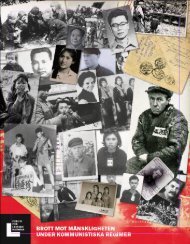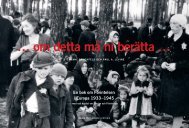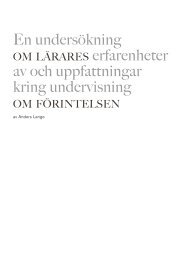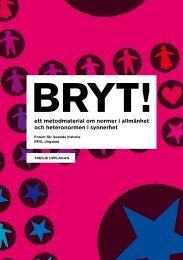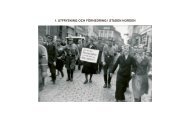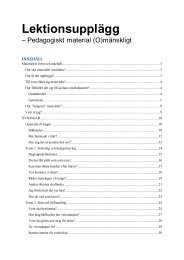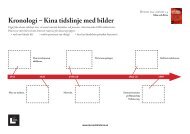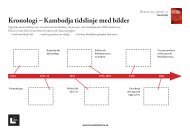Children…
Tell Ye Your Children... - Levandehistoria.se
Tell Ye Your Children... - Levandehistoria.se
- No tags were found...
You also want an ePaper? Increase the reach of your titles
YUMPU automatically turns print PDFs into web optimized ePapers that Google loves.
<br />
<br />
Sweden and the refugee crisis of 1938<br />
Refugees who changed Sweden<br />
Most Jews who applied for, and were granted, asylum in Sweden<br />
before the war came from Central Europe. The adults were often<br />
well-educated and had held prominent positions in their former<br />
countries. They could offer Sweden much in the fields of busi<br />
ness, medicine, literature, art and music. Of the 3,000 or so<br />
refugees admitted into Sweden, many contributed enormously.<br />
These included Nelly Sachs, author and later Nobel Prize laure<br />
ate, the journalist and author Stefan Szende, and entrepreneur<br />
”We have not been particularly generous<br />
with residence permits for foreigners<br />
who have applied for them in order to<br />
escape terror and persecution. Those who<br />
accuse the National Board of Health and<br />
Welfare of being too liberal in this respect<br />
may, when all is said and done, have less<br />
reason to criticise than those who claim<br />
that the Board has pursued too restrictive<br />
a policy.”<br />
SIGFRID HANSSON, NATIONAL HEALTH AND<br />
WELFARE BOARD DIRECTOR, ISSUING AGENCY<br />
FOR RESIDENCE PERMITS, FEBRUARY 1939<br />
Herbert Felix. Felix came to Sweden in 1938 and achieved rapid<br />
success in the food industry. After the war, he created his wellknown<br />
brand Felix. His products, ranging from relish to tomato<br />
ketchup, remain household names. Other refugees were only<br />
children when they arrived, and contributed to post-war Sweden.<br />
These included, among others, Harry Schein, Georg Riedel,<br />
Joachim Israel and Erwin Leiser.<br />
As soon as the Nazis came to power in 1933, Jews began<br />
leaving Germany. Most countries, Sweden included,<br />
were reluctant to accept more than a handful. When<br />
Germany annexed Austria in 1938, the European “refugee<br />
crisis” was aggravated, as tens of thousands of Jews<br />
tried to leave the Third Reich. As a result of an appeal<br />
from American president Franklin Roosevelt, representatives<br />
of 32 governments met in Évian, France, in<br />
July 1938 for a ten-day conference to discuss the crisis.<br />
The poorly planned conference was a humanitarian<br />
disaster. Government upon government expressed<br />
their regret for the Jewish plight, while simultaneously<br />
saying they could not help.The Swedish chief delegate,<br />
Gösta Engzell from the Ministry for Foreign Affairs,<br />
explained that Sweden had very limited possibilities to<br />
assist, and that the “burden” created by Europe’s Jewish<br />
“problem”, could only be borne if it was “extended to<br />
countries outside Europe”. Of all the large and small<br />
nations represented in Évian, only the tiny Dominican<br />
Republic in the Caribbean offered to receive 10,000<br />
Jews for a limited period of time. For many European<br />
Jews the failed conference effectively meant a death<br />
sentence. For Hitler and Nazi Germany, it served as<br />
a propaganda tool. The Nazis mocked a world which<br />
criticised Germany for its “Jewish policy”, while refusing<br />
to open its doors to Jewish refugees.The Évian fiasco<br />
is commonly considered to be the final demise of the<br />
League of Nations.<br />
56



